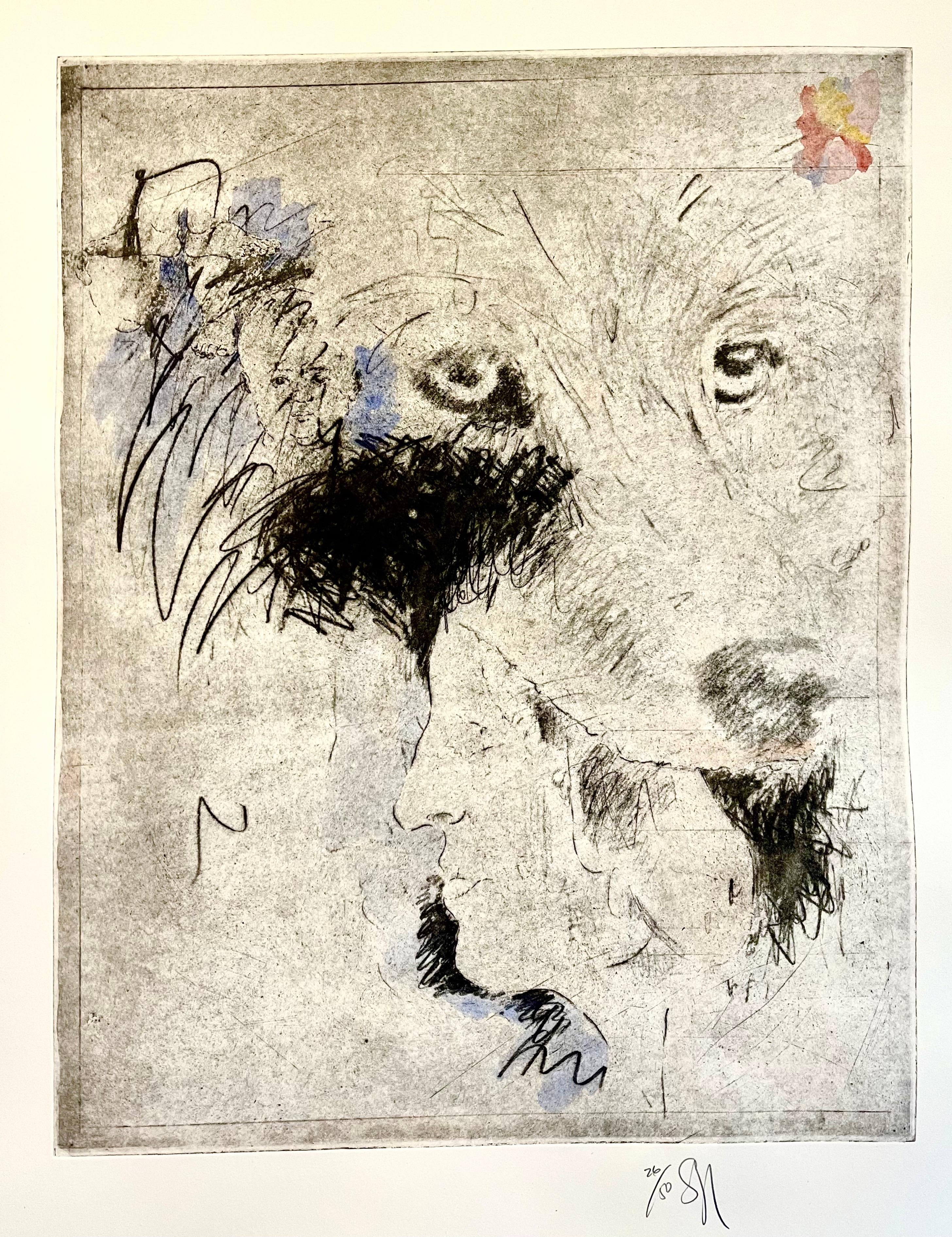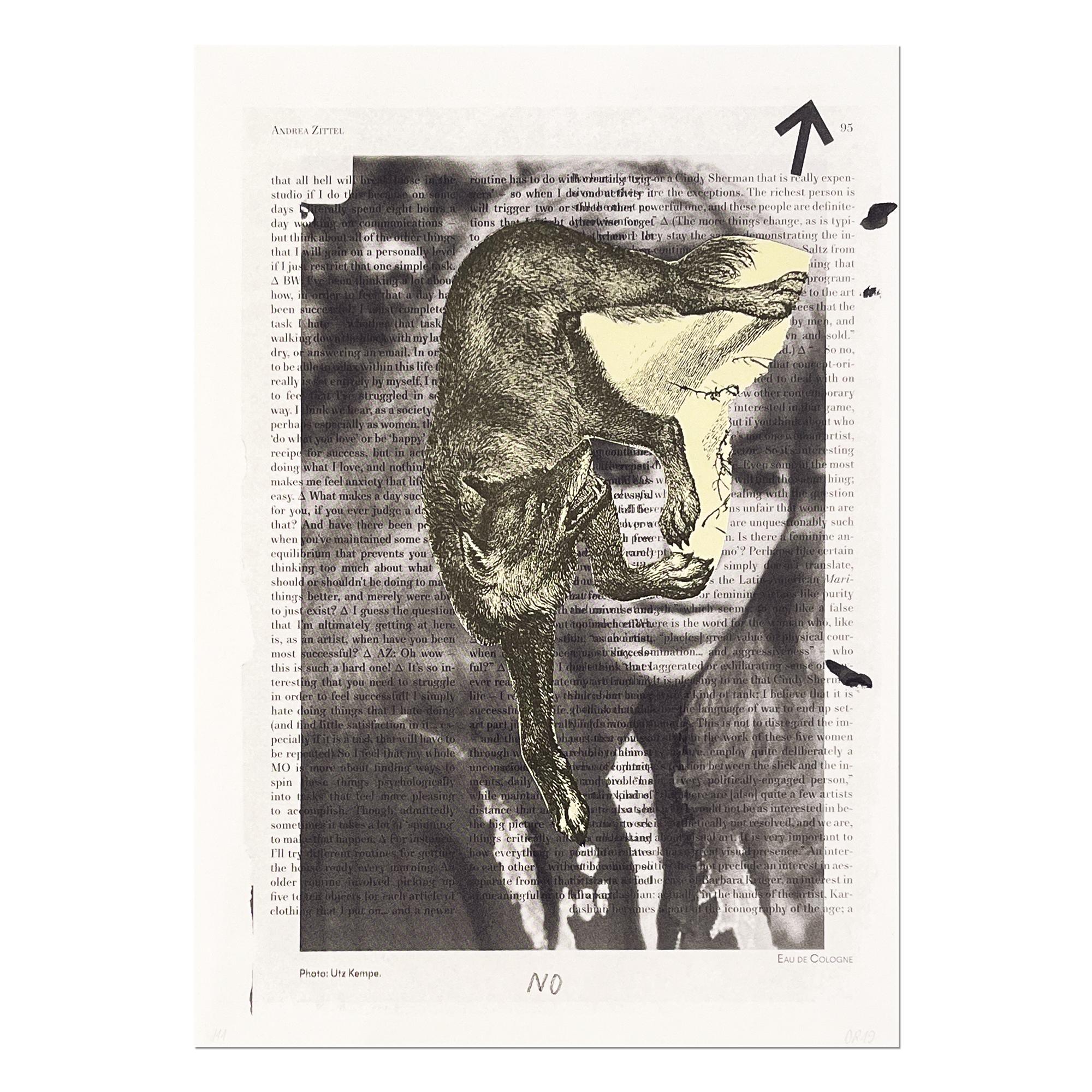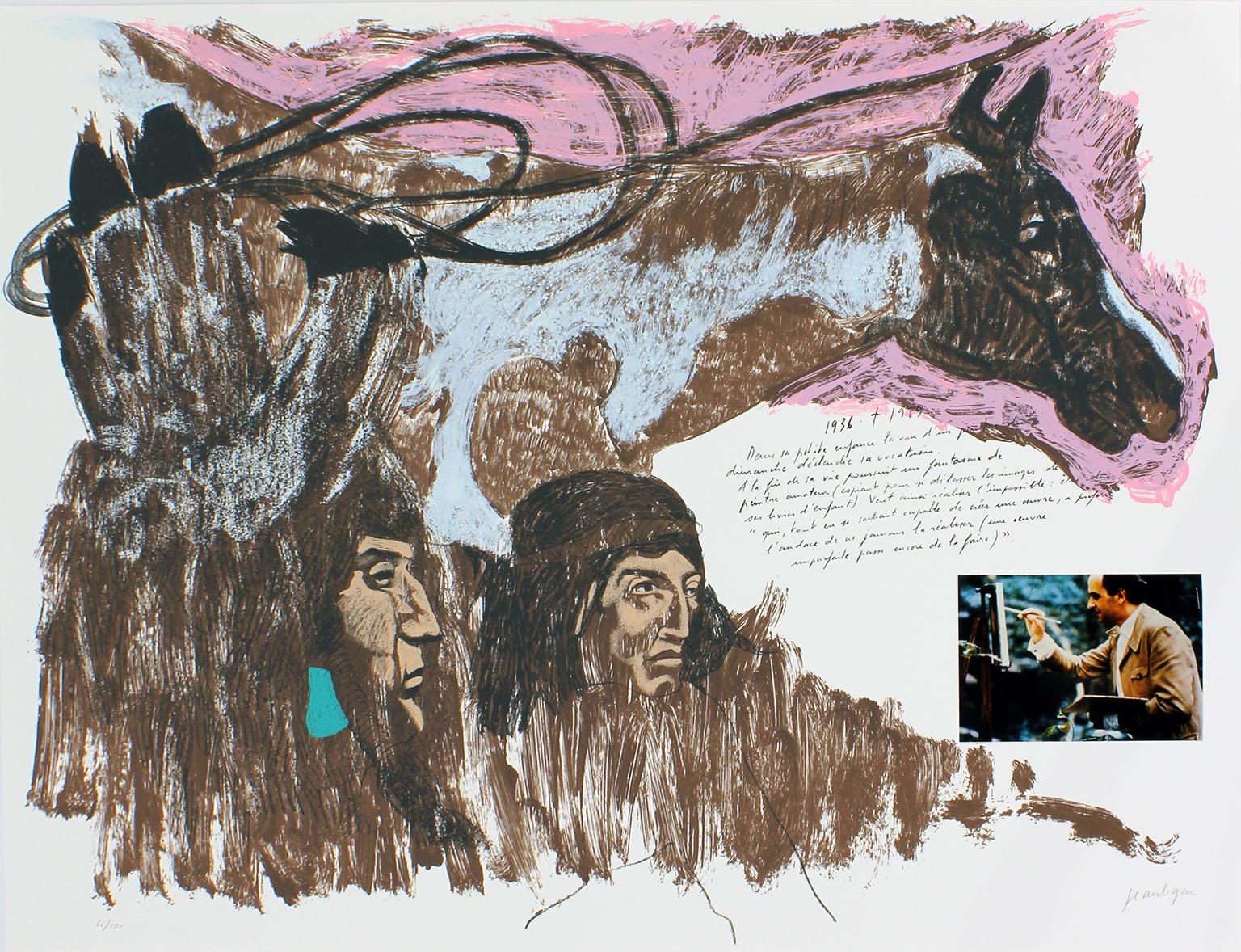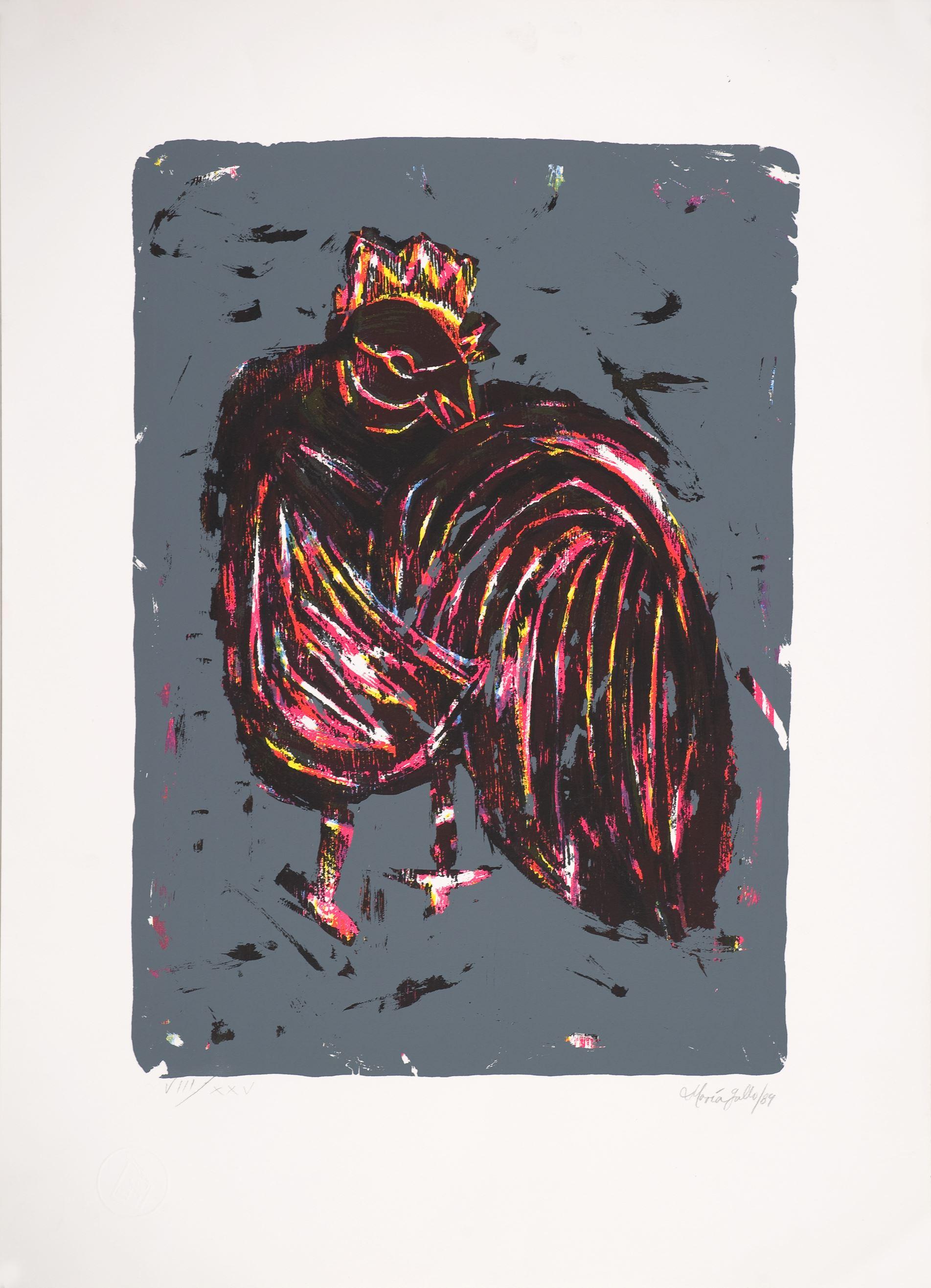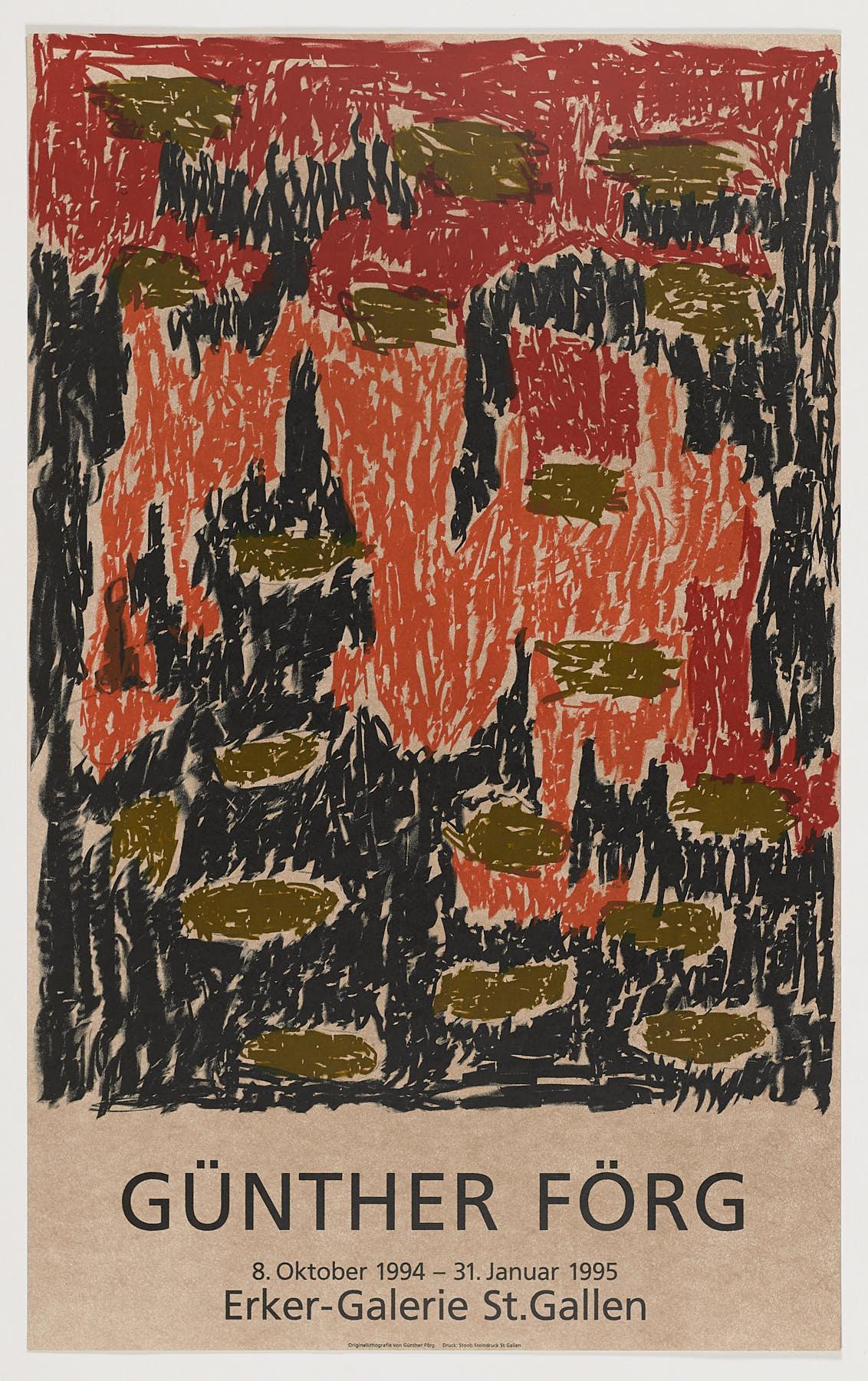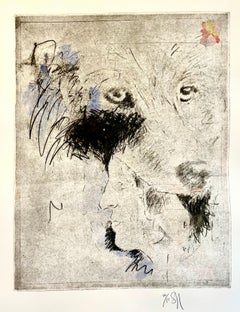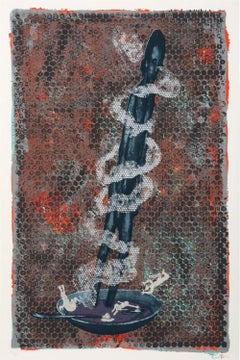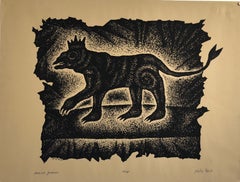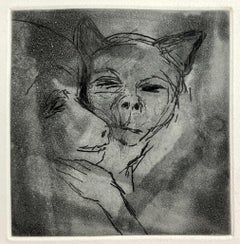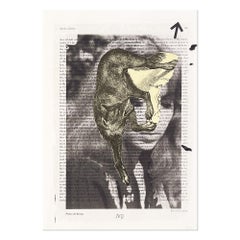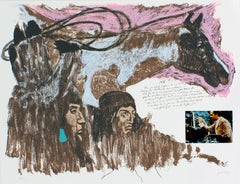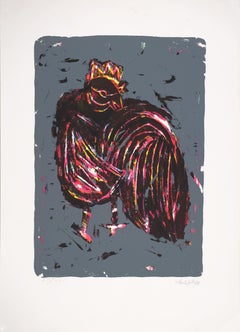Items Similar to Large German Junge Wilde Rainer Fetting Screenprint Serigraph Print Wolf Pop Art
Want more images or videos?
Request additional images or videos from the seller
1 of 10
Rainer FettingLarge German Junge Wilde Rainer Fetting Screenprint Serigraph Print Wolf Pop Art1984
1984
$1,900
£1,449.19
€1,650.27
CA$2,670.08
A$2,912.10
CHF 1,542.63
MX$34,911.91
NOK 19,646.28
SEK 17,965.07
DKK 12,329.17
About the Item
Rainer Fetting, (Germany, 1949-)
Wolf, 1984
Screenprint serigraph in colours, on wove paper, the full sheet.
Hand signed and numbered
34.5 X 49 inches
Rainer Fetting (Born 1949 in Wilhelmshaven, West Germany) is a German painter and sculptor.
Rainer Fetting was one of the co-founders and main protagonists of the Galerie am Moritzplatz in Berlin, founded in the late 1970s by a group of young artists (mainly painters) from the class of Karl Horst Hödicke at the former Berliner Hochschule für Bildende Künste (Berlin Art Academy, today known as Universität der Künste). This group of artists, known as the “Moritzboys” and including, among others, Salomé, Bernd Zimmer, and Helmut Middendorf, subsequently achieved international acclaim as the “Junge Wilde” or “Neue Wilde” in the early 1980s. In 1978, the Junge Wilde painting style arose in the German-speaking world in opposition to established avant garde, minimal art and conceptual art. It was linked to the similar Transavanguardia movement in Italy, USA (neo-expressionism) and France (Figuration Libre). The Junge Wilde painted their expressive paintings in bright, intense colors and with quick, broad brushstrokes very much influenced by Professor at the Academy of Art in Berlin, Karl Horst Hödicke They were also known as the Neue Wilde. Artists included; Austria: Siegfried Anzinger, Erwin Bohatsch, Herbert Brandl, Gunter Damisch, Hubert Scheibl, Hubert Schmalix, G.L. Gabriel-Thieler
Germany: Berlin: Luciano Castelli, Rainer Fetting, Andreas Walther, Helmut Middendorf, Salomé, Bernd Zimmer, Elvira Bach, Peter Robert Keil Cologne: Hans Peter Adamski, Peter Bömmels, Jiri Georg Dokoupil, Volker Tannert, Stefan Szczesny, A. R. Penck. Düsseldorf: Jörg Immendorff, Albert Oehlen, Markus Oehlen, Martin Kippenberger, Markus Lüpertz, Werner Buettner, Horst Gläsker, Peter Angermann. Fetting is now one of the internationally best known contemporary German artists, having created a large oeuvre of expressive figurative paintings covering many different kinds of subject-matter, as well as many bronze sculptures.
1972 – 1978 Studies painting at the Hochschule der Künste (Academy of Fine Arts), Berlin, with Prof. Hans Jaenisch
1977 Co-founder of the Galerie am Moritzplatz with Helmut Middendorf, Bernd Zimmer, Salomé, Anne Jud and Berthold Schepers.
1978 DAAD Scholarship for residence in New York
1983 – 1994 lives in New York and Berlin
1996 Willy Brandt sculpture for Willy Brandt House, Berlin
2005 Portrait sculpture of Henri Nannen for the Henri Nannen Press Award
2006 7 sculptures of Helmut Schmidt
Fetting lives and works in Berlin and on the island of Sylt, both Germany.
Artistic development
After having been trained as a carpenter and a stage designer at the Landesbühne Niedersachsen in Wilhelmshaven, Germany, Fetting moved to Berlin and enrolled at the Berliner Hochschule für Bildende Künste, studying painting with Hans Jaenisch from 1972 through 1978. In his final year at the academy he, together with Anne Jud, Helmut Middendorf, Stefan Roloff, Berthold Schepers, Salomé and Bernd Zimmer founded the Galerie am Moritzplatz as a self-help project, in order to be able to exhibit their colorful figurative paintings in an art scene still dominated by minimalism, conceptual art, as well as Berlin Realism. The artists exhibiting at the gallery basically formed the core of the art movement that came to be known and rapidly achieved international acclaim as the „Neue Wilde“ (or „Junge Wilde“). Fetting at the time focused on Berlin cityscapes, portraits and figurative work (e.g."Van Gogh At The Wall"), painted in strong colors, and including many depictions of the Berlin Wall. In 1980 he participated in the exhibition Heftige Malerei“ in the Haus am Waldsee, Berlin, in 1981 he was part of the exhibition New Spirit in Painting organized by Christos M. Joachimides and Norman Rosenthal at the Royal Academy of Arts in London, and in 1982 he participated in the exhibition “Zeitgeist” in the Martin-Gropius-Bau, Berlin. After that he had many solo exhibitions in reputable galleries both in Europe and in the United States, such as Bruno Bischofberger, Mary Boone, Yvon Lambert, Daniel Templon, the Marlborough Gallery, New York, or Anthony d'Offay. In early 1983, the Musée d'Art Contemporain de Bordeaux presented an exhibition of collaborative works by Luciano Castelli, Fetting, and Salomé. The three artists also performed the concert »Opéra par hasard« in Bordeaux and Paris (Fetting on drums). ). In 1984 he participated in the exhibitions Von hier aus – Zwei Monate neue deutsche Kunst in Düsseldorf and An International Survey of Recent Painting and Sculpture at the MoMA, New York, in 1988 he was part of the exhibition Refigured Painting – The German Image 1960–1988 at the Guggenheim Museum, New York. Between 1983 and 1994, Fetting spent part of his time in New York City, where he had already spent a year in 1978 on a grant from the DAAD. In his paintings, Fetting continued to explore the topic of the cityscape. Starting in 1984, while in New York, he experimented with assemblages of drift wood mounted on canvas and painted over. Paintings by Fetting were used as the works of Willem Dafoe's character in the 1985 film To Live and Die in L.A., in which Fetting had a cameo as a priest. In 1986, he also started doing bronze sculptures.
Exhibitions
Solo Exhibitions (selection)
Galerie am Moritzplatz, Berlin 1977, 1978
Anthony d’Offay, London 1981, 1982
Bruno Bischhofberger, Zurich 1981
Mary Boone, New York 1981, 1982
Paul Maenz, Cologne 1982
Yvon Lambert, Paris 1983
Marlborough Gallery, New York 1984, 1986
Galerie Daniel Templon, Paris 1985, 1987
Galerie Thomas, Munich 1985
Museum Folkwang, Essen 1986
Kunsthalle Basel, Basel 1986
Galerie Würthle, Vienna 1987
Raab Galerie, Berlin/London 1979, 1984, 1985, 1986, 1987, 1988, 1989, 1991, 1992, 1993
Museo di Barcelona, Barcelona 1989
Staatliche Museen zu Berlin, Nationalgalerie / DDR 1990
Stadtmuseum Weimar, Weimar 1990
Galleria Gian Ferrari Arte Contemporanea, Milan 1990
Harenberg City-Center, Dortmund 1994
Collection Martin Sanders, Staatliches Russisches Museum, St. Petersburg 1995
Galerie Tammen und Busch, Berlin 1995, 1996, 1999
Boukamel Contemporary Art Gallery (BCA), London 1998, 1999, 2000, 2002
Galerie Michael Schultz, Berlin 1999
NBK, Berlin 1999
Stiftung Schleswig-Holsteinisches Landesmuseum, Landesmuseum Schloß Gottorf 2000
Kunsthalle in Emden, Emden 2001
Galerie Borchardt, Hamburg 2004, 2005
Kunsthalle Wilhelmshaven, Wilhelmshaven 1997, 2005
Galerie Deschler, Berlin 2005, 2009
Studio d’Arte Cannaviello, Milan 1983, 1985, 1986, 1988, 2007
Galerie Pfefferle, Munich 1988, 1991, 1992, 1994, 1996, 1997, 2000, 2002, 2004, 2006, 2008
Gerhard Marcks Haus, Bremen, 2008
Toskanische Säulenhalle, Augsburg, 2009
Kunsthalle Tübingen, 2010
Berlinische Galerie – Museum of Modern Art, Photography and Architecture, 2011
Group Exhibitions (selection)
„Heftige Malerei”, Haus am Waldsee, Berlin 1980
„A New Spirit in Painting”, Royal Academy of Art, London 1981
„Berlin, eine Stadt für Künstler", Kunsthalle Wilhelmshaven, Wilhelmshaven 1982
„Zeitgeist”, Martin-Gropius-Bau, Berlin 1982
„New Art”, Tate Gallery, London 1983
„Castelli, Salomé, Fetting”, CAPC, Bordeaux 1983
„Origin y Vision: Nueva Pintura Alemana”, Centre Cultural de la Caixa de Pensions Barcelona; Palacio Velázquez, Madrid (ES); Museo de Arte Moderno, Mexico City (MX) 1984
„An International Survey of Recent Painting and Sculpture“, Museum of Modern Art, New York 1984
„Berlinart 1967–1987”, Museum of Modern Art, New York 1987
Museum of Modern Art, San Francisco 1987
Toledo Museum of Art, Toledo 1988
„Refigured Painting. The German Image 1960–1988”, Guggenheim Museum, New York 1989
„New Paintings from Berlin”, Tel Aviv Museum, Tel Aviv 1992
„The Portrait Now”, National Portrait Gallery, London 1993
“Sammlung Piepenbrock. Farbe.Form.Zeichen”, Stiftung Schleswig-Holsteinische Landesmuseen Schloß Gottorf, 2002
„Expressiv”, Fondation Beyeler, Riehen/Basel 2003
„Obsessive Malerei”, zkm, Karlsruhe 2003
„Go, Johnny, Go!”, Kunsthalle Wien, Vienna 2003
„Il Nudo”, Galleria d´Arte moderna, Bologna 2004
„(my private) Heroes”, Museum MARTa Herford, Herford 2005
„Deutsche Bilder aus der Sammlung Ludwig”, Ludwigsgalerie Schloss Oberhausen, Oberhausen 2006
„Kunst und Kanzler”, Villa Grisebach, Berlin 2007
„Von Spitzweg bis Baselitz. Streifzüge durch die Sammlung Würth“, Forum Würth Arlesheim, Arlesheim 2007
„Feldforschung Stadt > 29 Antworten. Bilder gesellschaftlichen Wandels 2. Eine Kooperation der Schrader-Stiftung und des Hessischen Landesmuseums Darmstadt“, Galerie der Schrader-Stiftung, Darmstadt 2007
„Getroffen. Otto Dix und die Kunst des Porträts“, Kunstmuseum Stuttgart, Stuttgart 2007
„Arte e Omosessualità. da von Gloeden a Pierre Gilles“, Palazzo della Ragione, Mailand 2007
“Berlin 89/09- Kunst zwischen Spurensuche und Utopi”, Berlinische Galerie– Landesmuseum für Moderne Kunst, Fotografie und Architektur, Berlin 2009
„20 Jahre Deutsche Einheit 1989–2009. Kunst im Schatten der Grenze“, Kunsthalle Schweinfurt, 2009
„FALLMAUERFALL 61-89-09“, Ephraim Palais, Stadtmuseum Berlin, 2009
„Macht zeigen – Kunst als Herrschaftsstrategie“, Deutsches Historisches Museum Berlin 2010
„Nudes“ Galerie Bischofberger Zürich (CH), 2010
„The 80s Revisited- aus der Sammlung Bischofberger“, Kunsthalle Bielefeld 2010
„Körpernah- Akte/ Nudes“ Galerie Tammen Berlin, 2010
“Animal Magnetism” Galerie Deschler, Berlin 2010
“Berlin zeichnet!” Ludwig Museum Koblenz 2010
“Walking the dog” Kunsthalle Osnabrück 2010
„Der heilige Augenblick. Il Santo Momento“ Museum am Dom, Würzburg 2011
„Aller Zauber liegt im Bild. Zeitgenössische Kunst der Benediktinerabtei Maria Laach in der Sammlung Würth“ Museum Würth, Künzelsau 2011
„Schönheit und Natur Skulpturen am Rheinkilometer 529“, Gerda und Kuno Pieroth Stiftung, Bingen am Rhein 2011
"Painting Forever! Keilrahmen", KW Institute for Contemporary Art, Berlin 2013
Public Collections
Berlin Museum, Germany
Berlinische Galerie, Landesmuseum für Moderne Kunst, Fotografie und Architektur, Berlin, Germany
Fonds Régional d`Art Contemporain, Auvergne, France
Nationalgalerie, Berlin, Germany
Hamburger Bahnhof, Museum for Contemporary Art, Berlin (Collection Dr. Erich Marx), Germany
Kunsthalle Emden, Henri und Eske Nannen Foundation, Germany
Collection Würth, Künzelsau, Germany
Collection Ludwig, Schloss Oberhausen, Germany
Museum of Contemporary Art/ ZKM Karlsruhe, Germany
Museum Folkwang, Essen, Germany
Stiftung Kunstforum Berliner Volksbank, Germany
Bundeskanzleramt (Chancellery), Berlin, Germany
German Bundestag, Germany
Sammlung des Bundesinnenministeriums (Collection of the Federal Ministry of the Interior), Bonn, Germany
Kunsthalle Kiel, Germany
Museum Ludwig, Aachen, Germany
Bavarian Academy of Fine Arts, Munich, Germany
Foundation Haus der Geschichte, Bonn, Germany
Museum Gunzenhauser, Chemnitz, Germany
Museum am Dom, Würzburg, Germany
Hessisches Landesmuseum Darmstadt, Germany
Kunsthalle Wilhelmshaven, Germany
Rogaland Museum of Fine Art, Stavanger, Norway
Museum für Gegenwartskunst, Basel, Switzerland
Museum des 20. Jahrhunderts, Wien, Austria
National Museum of Art, Architecture and Design, Oslo, Norway
Sintra Museum of Modern Art, Portugal
Musée Cantini, Marseille, France
Musée Cannes, France
Musée d‘Art Contemporain, Bourg-en-Bresse, France
Musée de la Passion, Lille, France
Berkeley Museum, California, USA
Remington Collection, Detroit, USA
Virginia Museum of Fine Arts, Richmond, Virginia, USA
Weisman Collection, Los Angeles, USA
Museum of Contemporary Art San Diego, USA
Art Gallery of South Australia, Adelaide, Australia
Kunstsammlung Gera
Städel Museum Frankfurt/ Main
Portland Art Museum, Oregon, USA
About the Seller
4.9
Platinum Seller
Premium sellers with a 4.7+ rating and 24-hour response times
Established in 1995
1stDibs seller since 2014
1,843 sales on 1stDibs
Typical response time: 1 hour
- ShippingRetrieving quote...Shipping from: Miami, FL
- Return Policy
More From This Seller
View AllLarge Donald Saff Surrealist Pop Art Aquatint Etching Wolf, Man
By Donald Saff
Located in Surfside, FL
Artist: Donald Saff
Title: Wolf and Man
Year: 1980
Medium: Etching with Aquatint, Hand signed and numbered in pencil
Edition: 50
39 in. x 27.5 in.
Donald Jay Saff (born 12 Decemb...
Category
1980s Pop Art Figurative Prints
Materials
Etching, Aquatint
Large Silkscreen Serigraph Neo Figurative Expressionist Print Jorg Immendorff
By Jörg Immendorf
Located in Surfside, FL
Jorg Immendorff (German, 1945-2007)
Untitled, Germany, 2006
serigraph
hand signed and dated lower right margin, numbered 20/27 lower left
framed
74.5 x 48.75 inches (sight).
82.25 x 55.5 inches (frame).
This work is number 20 from the edition of 27.
Provenance: T. Kreuzer Gallery, Cologne, Friedman Benda Gallery, New York City
Jörg Immendorff (1945–2007) was a German painter, sculptor, stage designer and art professor. He was a member of the art movement Neue Wilde. He worked as a painter, sculpture and print maker in steel, bronze, oil painting, lithography etching and serigraphy.
Immendorff was born in Bleckede, Lower Saxony, near Lüneburg on the west bank of the Elbe. He attended the boarding School Ernst-Kalkuhl Gymnasium as a student. At the age of sixteen he had his first exhibition in a jazz hall cellar in Bonn.
Beginning in 1963, Immendorff studied at the Art Academy in Düsseldorf (Kunstakademie Düsseldorf). Initially he studied for three terms with the theater designer Teo Otto. After Otto threw him out of his class for refusing to let one of his paintings serve as stage-set decoration, Immendorff was accepted as a student by Joseph Beuys. The academy expelled him because of some of his (left-wing) political activities and neo-dada actions.
From 1969 to 1980, Immendorff worked as an art teacher at a public school, and then as a free artist, holding visiting professorships all over Europe. In 1989, he became professor at the Städelschule in Frankfurt am Main and in 1996 he became professor at the Art Academy in Düsseldorf—the same school that had dismissed him decades earlier as a student.
Jörg Immendorff often worked in "grand cycles of paintings" that often lasted years at a time and were political in nature. Notable cycles include LIDL, Maoist Paintings, Cafè Deutschland , and The Rake's Progress. The first body of work that Immendorff gave a name to were his LIDL paintings, sculptures, performances, and documents, that he executed during 1968-1970. The name, "LIDL" was inspired by the sound of a child's rattle makes and much of his work from this period included the iconography of new beginnings and innocence. LIDL is comparable to Dadaist but unlike the Dada movement it never became an established group but rather consisted of a variety of artists (including James Lee Byars, Marcel Broodthaers, Nam June Paik, and Joseph Beuys) participating in actions and activities.
In January 1968 he appeared in front of the West German Parliament in Bonn with a wood block labeled “Lidl” tethered to his ankle and painted in the colors of the German flag; he was subsequently arrested for defaming the flag.
Best known is his Cafe Deutschland series of sixteen large paintings (1977–1984) that were inspired by Renato Guttuso Caffè Greco; in these crowded colorful pictures, Immendorff had disco-goers symbolize the conflict between East and West Germany. Since the 1970s, he worked closely with the painter A. R. Penck from Dresden (in East Germany).
Immendorff created several stage designs, including two for the Salzburg Theater Festival. He designed sets for the operas Elektra and The Rake's Progress. The latter also inspired a series of paintings in which he cast himself as the rake.
In 1984, Immendorff opened the bar La Paloma near the Reeperbahn in Hamburg St. Pauli and created a large bronze sculpture of Hans Albers there. He also contributed to the design of Andre Heller's avant-garde amusement park "Luna, Luna" in 1987. Immendorff created various sculptures; one spectacular example is a 25 m tall iron sculpture in the form of an oak tree trunk, erected in Riesa in 1999. In 2006, Immendorff selected 25 of his paintings for an illustrated Bible. In the foreword he described his belief in God.
A major 2019 survey began at the Haus der Kunst in Munich and later traveled later to the Museo Reina Sofía in Madrid and the Fondazione Querini Stampalia in Venice, curated by Francesco Bonami. In 2000, Immendorff married his former student Oda Jaune. The have one daughter Ida Immendorff. He was a member of the Junge Wilde (German for "young wild ones")
In 1978, the Junge Wilde painting style arose in the German-speaking world in opposition to established avant garde, minimal art and conceptual art. It was linked to the similar Transavanguardia movement in Italy, USA (neo-expressionism) and France (Figuration Libre). The Junge Wilde painted their expressive paintings in bright, intense colors and with quick, broad brushstrokes very much influenced by Professor at the Academy of Art in Berlin, Karl Horst Hödicke (b:1938). They were sometimes called the Neue Wilde. Berlin: Luciano...
Category
Early 2000s Neo-Expressionist Abstract Prints
Materials
Screen
Large Post Soviet Non Conformist Russian Israeli Animal Beast Lithograph Print
By Michail Grobman
Located in Surfside, FL
Silkscreen Serigraph print hand signed, numbered.
Michail Grobman (Russian: Михаил Гробман, Hebrew: מיכאיל גרובמן, born 1939) is an artist and a poet working in Israel and Russia....
Category
20th Century Modern Animal Prints
Materials
Lithograph, Screen
Small Beasts (Dog) Aquatint Etching Jim Dine Pop Art Print
By Jim Dine
Located in Surfside, FL
Jim Dine (American, b. 1935)
Etching depicting a dog or wolf
Published by Enitharmon Press for Whitman College, London 1999
Hand signed in pencil lower right. Measures 9" x 7" sheet...
Category
1990s Pop Art More Prints
Materials
Drypoint, Etching
British Pop Art Artist RB Kitaj Screenprint Day Book Serigraph Silkscreen Signed
By Ronald Brooks Kitaj
Located in Surfside, FL
R.B. Kitaj (British American 1932-2007)
Hand signed and numbered
Screenprint
Measures approximately 24.5 X 16.65 inches
This is from the Robert Creeley daybook. They were done in ...
Category
1970s Pop Art Figurative Prints
Materials
Screen
Emil Schumacher Limited Edition Serigraph Terraraph Print Abstract Art Informel
Located in Surfside, FL
Heavily textured abstract print in a serigraph and terragraph technique. It has a raised texture to the surface, A beautiful piece. This listing is for the one print, the cover justification sheet and the photograph are just included for provenance.
This is from the limited edition of 100. Hand signed and numbered on colophon page. (They are not signed and numbered on each print) Arches paper.
Dimensions: 15.75 X 15.25 These have a texture that feels like a painting. Done in Jaffa Israel based on the Hebrew Bible. Jewish, Judaica interest.
Emil Schumacher is among the best-known exponents of Art Informel in Germany. His painting style, which he initially developed in the 1950s under the influence of Wols, is marked by dark, brownish black or brilliant thick red colours and a graffiti like sign language that endow the pictures the expressive character of old cracked masonry.
Emil Schumacher (29 August 1912 in Hagen, Westfalen – 4 October 1999 in San José, Ibiza) was a German artist and painter. He was an important representative of abstract expressionism in post-war Germany.
As an 18-year-old, Emil Schumacher undertakes a four-week-long bicycle tour to Paris, France.
1932–1935: Studies graphic design at the School of Applied Arts in Dortmund intending to become a graphic designer in advertising.
1935–1939: Independent artist without participating in exhibits. He undertakes study trips by bicycle to the Netherlands and Belgium.
1939–1945: Service obligation as draftsman in an arms factory, the Akkumulatoren–Werke of Hagen.
Since 1945: Immediately after end of war, new start as independent artist.
1947: First solo exhibit in the Studio für neue Kunst. Co-founder of the artist group Junger Westen.
1954: Participates in the Willem Sandberg...
Category
20th Century Abstract Expressionist Abstract Prints
Materials
Screen
You May Also Like
Wild Wolves - Original Lithograph, Stamp Signature
By Pierre Ambrogiani
Located in Paris, IDF
Pierre AMBROGIANI (1907-1985)
Wolves, 1974
Original Lithograph (Gourdon Workshop)
Signed with the artist's stamp
On vellum 38 x 28 cm (c. 14.9 x 11 in)
Excellent condition
Category
Mid-20th Century Expressionist Animal Prints
Materials
Lithograph
Daniel Richter, Untitled (Fuchs) - Signed Screenprint, Collage, Contemporary Art
By Daniel Richter
Located in Hamburg, DE
Daniel Richter (German, born 1962)
Untitled (from 11 Screenprints), 2019
Medium: Screenprint on paper
Dimensions: 59.4 x 42 cm
Edition of 11: Hand-signed and numbered
Condition: Exce...
Category
21st Century and Contemporary Abstract Abstract Prints
Materials
Screen
"Untitled" serigraph with color photo by Jean Le Gac from "Kinderstern"
Located in Boca Raton, FL
"Untitled" serigraph of Native Americans and horse with attached color photo by artist Jean Le Gac from the "Kinderstern" portfolio, published in 1989 by Edition Domberger to raise m...
Category
1980s Contemporary Animal Prints
Materials
Screen
Maria Gallo Nicaraguan Artist Original Hand Signed silkscreen animal print
Located in Miami, FL
María Gallo (Nicaragua, 1954)
'S/T 1', N/A
silkscreen on paper
27.6 x 19.7 in. (70 x 50 cm.)
Edition of 25
ID: GAL1401-001-025
Unframed
Hand-signed by author
Category
21st Century and Contemporary Contemporary Prints and Multiples
Materials
Engraving, Screen, Paper
Günther Förg German Artist 1995 Original Poster lithograph
By Günther Förg
Located in Miami, FL
Günther Förg (Germany, 1952-2013)
'Erker-Gallery', 1995
Original poster from exhibition of 1995
lithograph on paper
36.5 x 22.6 in. (92.7 x 57.4 cm.)
Unframed
Ref: FOR100-201
Günthe...
Category
1990s Expressionist Abstract Prints
Materials
Lithograph
Green Cat, CoBrA Group Modern Lithograph by Karel Appel
By Karel Appel
Located in Long Island City, NY
This signed and numbered lithograph on Japon paper is from a portfolio of 17 prints by Modern artist Karel Appel. He admired the domestic house cat for its aloof, yet instinctive, de...
Category
1970s Modern Animal Prints
Materials
Lithograph
More Ways To Browse
Vintage Bavarian
Vintage Gill
Vintage Norwegian Art
Markus Lupertz
Paris Scene Painting Signed Andrea
Gerhard Marcks
Bernd Zimmer
Luciano Castelli
Herbert Brandl
Maria Laach
Hubert Scheibl
Paul Lambert
Charles Le Bars
Dali Fontaine
Duck Etching
George Edwards Antique Bird Prints
George Edwards Bird Prints
Hockney Dachshund
